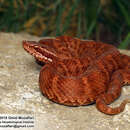Gloydius is a genus of venomous pitvipers endemic to Asia, also known as Asian moccasins or Asian ground pit vipers. Named after American herpetologist Howard K. Gloyd,[2] this genus is very similar to the North American genus Agkistrodon. 24 species are currently recognized.[3]
Geographic range
Species of Gloydius are found in Russia, east of the Ural Mountains through Siberia, Iran, Himalayas from Pakistan, India, Nepal, China, Korea, Japan and the Ryukyu Islands.[1]
Species
Species
[3] Taxon author
[3] Subsp.*
[3] Common name
[4] Geographic range
[1] G. angusticeps Shi, Yang, Huang Orlov, & Li, 2018 0 Zoige pit viper
China, (Sichuan, Qinghai, and Gansu).
G. blomhoffii (
H. Boie, 1826) 3 Japanese mamushi
Japan.
G. brevicauda (
Stejneger, 1907) 0 Short-tailed mamushi
North Korea,
South Korea, and
China.
G. caraganus (
Eichwald, 1831) 0 Karaganda pitviper
Uzbekistan,
Turkmenistan,
Tajikistan,
Kyrgyzstan, and
Kazakhstan.
G. caucasicus (
Nikolsky, 1916) 0 Caucasian pitviper
Turkmenistan,
Azerbaijan,
Iran, and
Afghanistan.
G. chambensis Kuttalam, Santra, Owens, Selvan, Mukherjee, Graham, Togridou, Bharti, Shi, Shanker & Malhotra, 2022
[5] 0 Chamba pitviper
Chamba District,
Himachal Pradesh.
G. changdaoensis Li, 1999 0
China.
G. cognatus (Gloyd, 1977) 0 Alashan pitviper
China.
G. halysT (
Pallas, 1776) 4 Siberian pitviper
Russia, east of the
Ural Mountains through
Siberia,
Iran,
Mongolia to northern and central
China, as well as the southern
Ryukyu Islands.
G. himalayanus (
Günther, 1864) 0 Himalayan pitviper Along the southern slopes of the
Himalayas from northeastern
Pakistan, to northern
India (
Kashmir,
Punjab) and
Nepal. Found at 1524–3048 m altitude.
G. huangi Wang, Ren, Dong, Jiang, Shi, Siler, & Che, 2019 0 Lancang Plateau viper Tibet.
G. intermedius (
Strauch, 1868) 2 Central Asian pitviper Southeastern
Azerbaijan, northern Iran, southern
Turkmenistan, northwestern
Afghanistan, southern Russia, northwestern China and Mongolia.
G. lateralis Zhang,
Shi,
Li,
Yan,
Wang,
Ding,
Du,
Plenković-Moraj,
Jiang,
Shi, 2022 0
Jiuzhaigou County,
China.
[6] G. lipipengi Shi, Liu, Giri, Owens, Santra, Kuttalam, Selvan, Guo, & Malhotra, 2021 0 Nujiang pit viper
China.
G. liupanensis Liu, Song, & Luo, 1989 0 Gansu,
China.
G. monticola (
F. Werner, 1922) 0 Likiang pitviper The mountains of northern
Yunnan in China.
G. qinlingensis Song & Chen, 1985 0 Shaanxi,
China.
G. rickmersi Wagner, Tiutenko, Borkin, & Simonov, 2015 Kyrgyzstan
G. rubromaculatus Shi,
Wang,
Chen,
Fang,
Ding,
Huang,
Hou,
Liu, &
Li, 2017 0 Tibetan Plateau.
G. saxatilis (
Emelianov, 1937) 0 Rock mamushi
[7] Russia (eastern
Siberia), northeastern China and
North and
South Korea.
G. shedaoensis (
Zhao, 1979) 0 Shedao island pitviper Shedao Island, off the coast of
Liaotung, China.
G. stejnegeri (
Rendahl, 1933) 0 Gobi pitviper
China and
Mongolia.
G. strauchi (
Bedriaga, 1912) 0 Strauch's pitviper The
Tibetan Plateau in the provinces of
Tsinghai and western
Szechwan, China.
G. swild Shi, Liu, Giri, Owens, Santra, Kuttalam, Selvan, Guo, & Malhotra, 2021 0
China.
G. tsushimaensis (
Isogawa,
Moriya &
Mitsui, 1994) 0 Tsushima Island pitviper
Tsushima Island,
Japan.
G. ussuriensis (Emelianov, 1929) 0 Ussuri mamushi Far east Russia (
Primorskiy Kray), northeastern China, North and South Korea, as well as
Quelpart Island.
*) Not including the nominate subspecies.
T) Type species.
Taxonomy
Due to the strong morphological similarity, these snakes were classified in the genus Agkistrodon until very recently. However, by 1999 cladistic studies clearly showed that Agkistrodon did not form a clade (indeed, it was not even paraphyletic) and was thus split into several genera.
A new species, G. tsushimaensis, was described by Isogawa, Moriya & Mitsui (1994). It is referred to as the Tsushima island pitviper and is found only on Tsushima Island, Japan.
References
-
^ a b c McDiarmid RW, Campbell JA, Touré TA (1999). Snake Species of the World: A Taxonomic and Geographic Reference, Volume 1. Washington, District of Columbia: Herpetologists' League. 511 pp. ISBN 1-893777-00-6 (series). ISBN 1-893777-01-4 (volume).
-
^ Beolens, Bo; Watkins, Michael; Grayson, Michael (2011). The Eponym Dictionary of Reptiles. Baltimore: Johns Hopkins University Press. xiii + 296 pp. ISBN 978-1-4214-0135-5. (Gloydius, p. 102).
-
^ a b c d "Gloydius ". Integrated Taxonomic Information System. Retrieved 17 October 2006.
-
^ Gumprecht A, Tillack F, Orlov NL, Captain A, Ryabov S (2004). Asian Pitvipers. First Edition. Berlin: Geitje Books. 368 pp. ISBN 3-937975-00-4.
-
^ Kuttalam, S.; Santra, V.; Owens, J. B.; et al. (2022). "Phylogenetic and morphological analysis of Gloydius himalayanus (Serpentes, Viperidae, Crotalinae), with the description of a new species". European Journal of Taxonomy (852): 1–30. doi:10.5852/ejt.2022.852.2003. S2CID 254676412.
-
^ Zhang, Mei-Hua; Shi, Sheng-Chao; Li, Cheng; Yan, Peng; Wang, Ping; Ding, Li; Du, Jie; Plenković-Moraj, Anđelka; Jiang, Jian-Ping; Shi, Jing-Song (2022-07-25). "Exploring cryptic biodiversity in a world heritage site: a new pitviper (Squamata, Viperidae, Crotalinae) from Jiuzhaigou, Aba, Sichuan, China". ZooKeys (1114): 59–76. doi:10.3897/zookeys.1114.79709. ISSN 1313-2970. PMC 9848824. PMID 36761701.
-
^ Gloyd HK, Conant R (1990). Snakes of the Agkistrodon Complex: A Monographic Review. Society for the Study of Amphibians and Reptiles. 614 pp., 52 plates. LCCN 89-50342. ISBN 0-916984-20-6.

